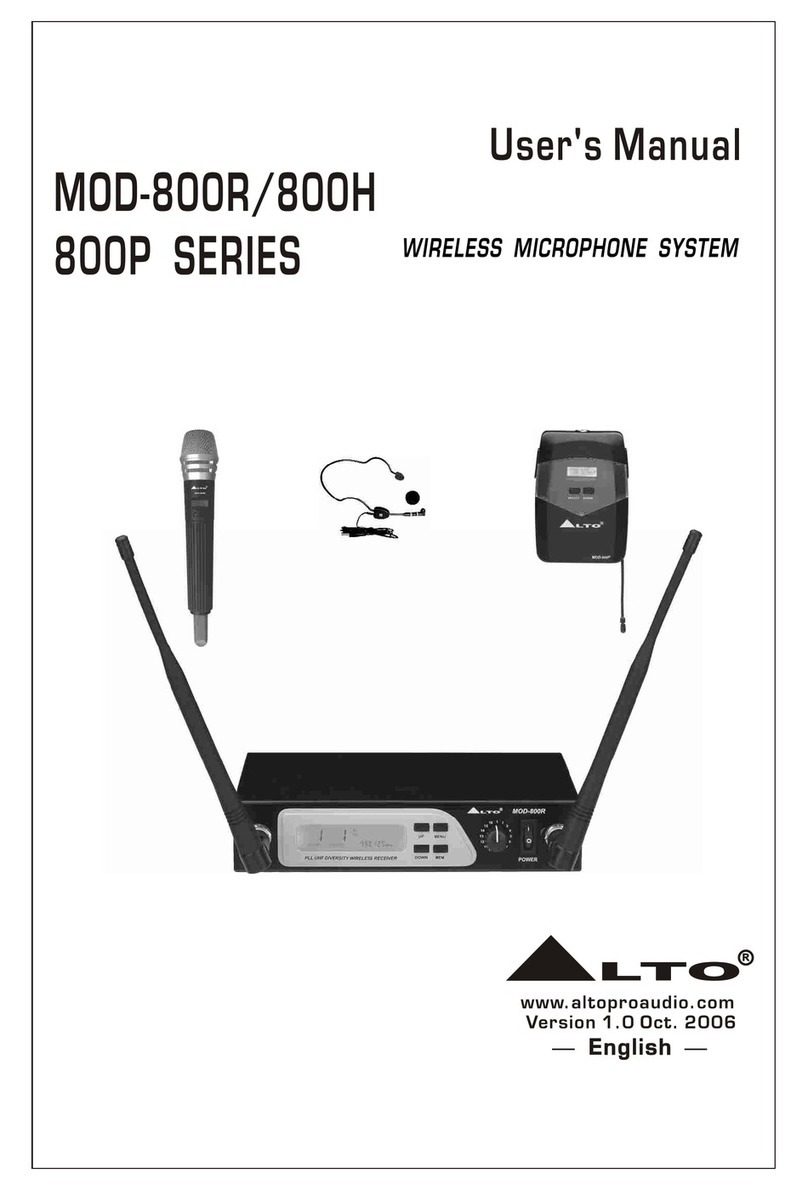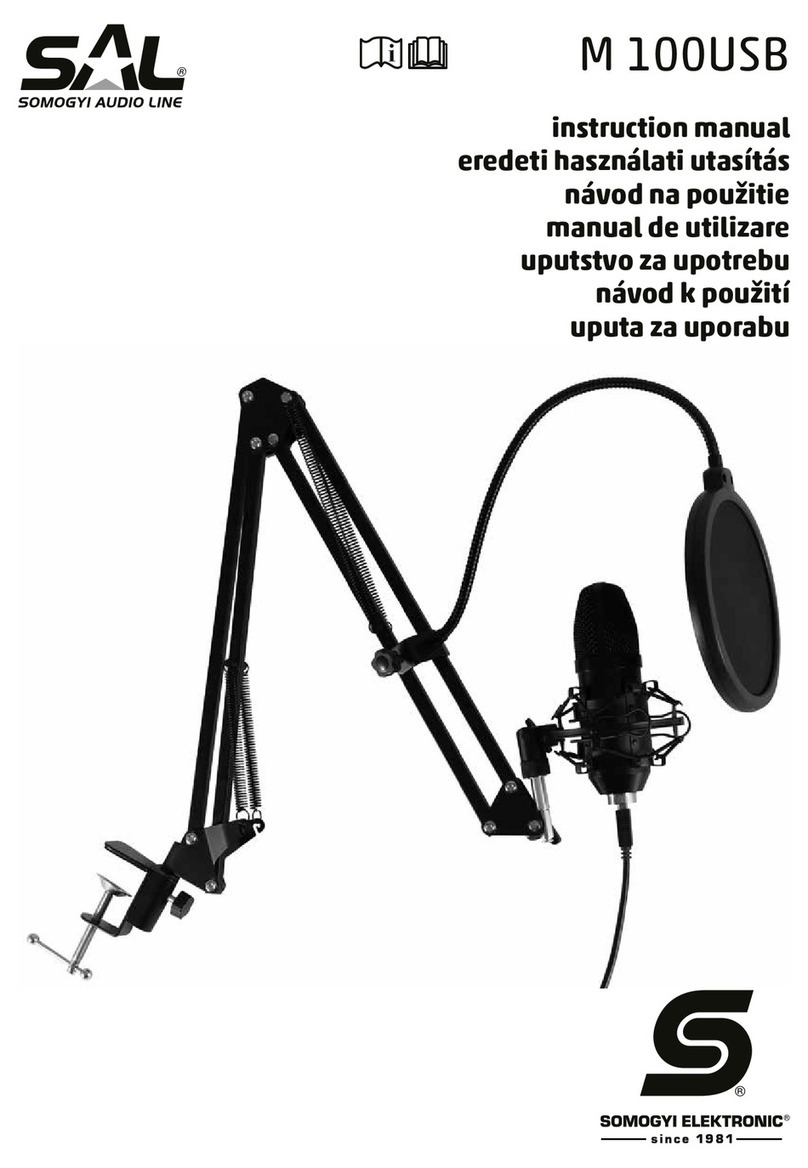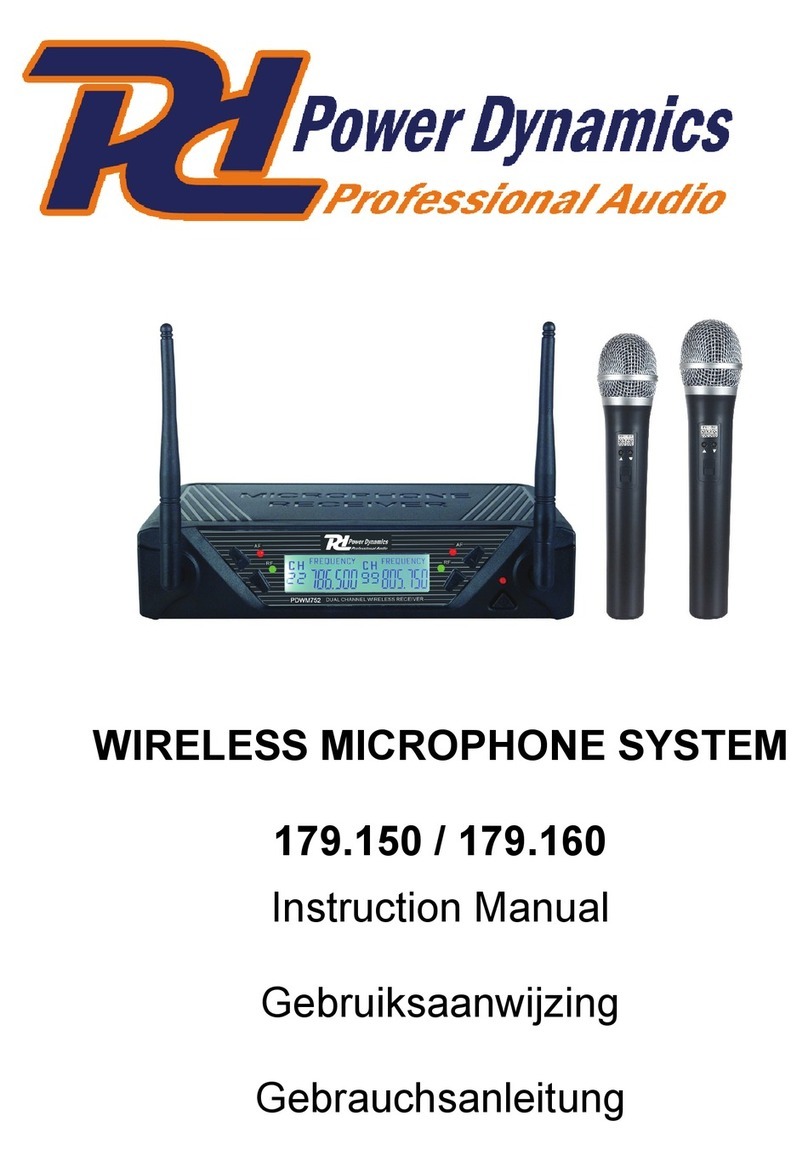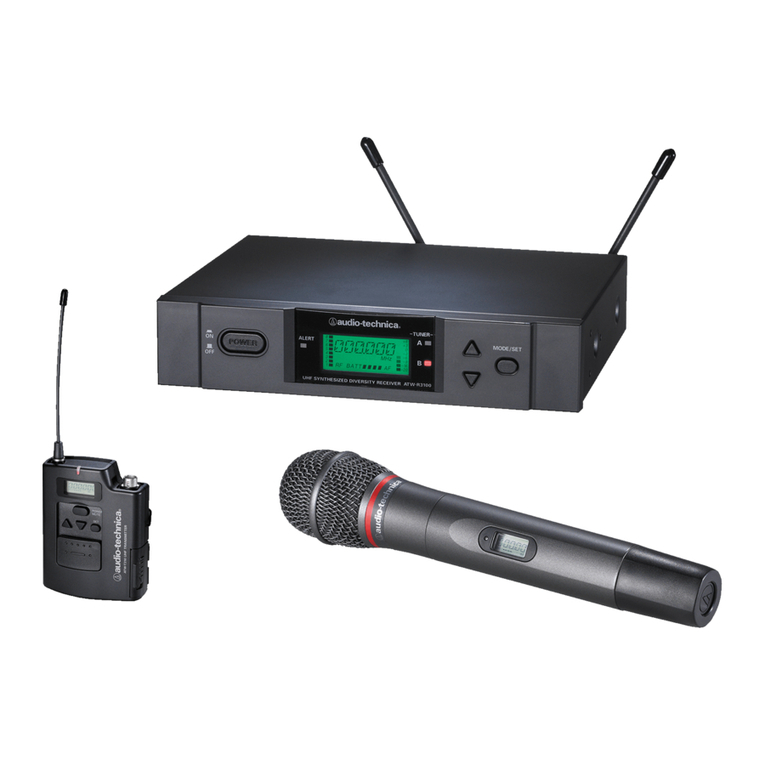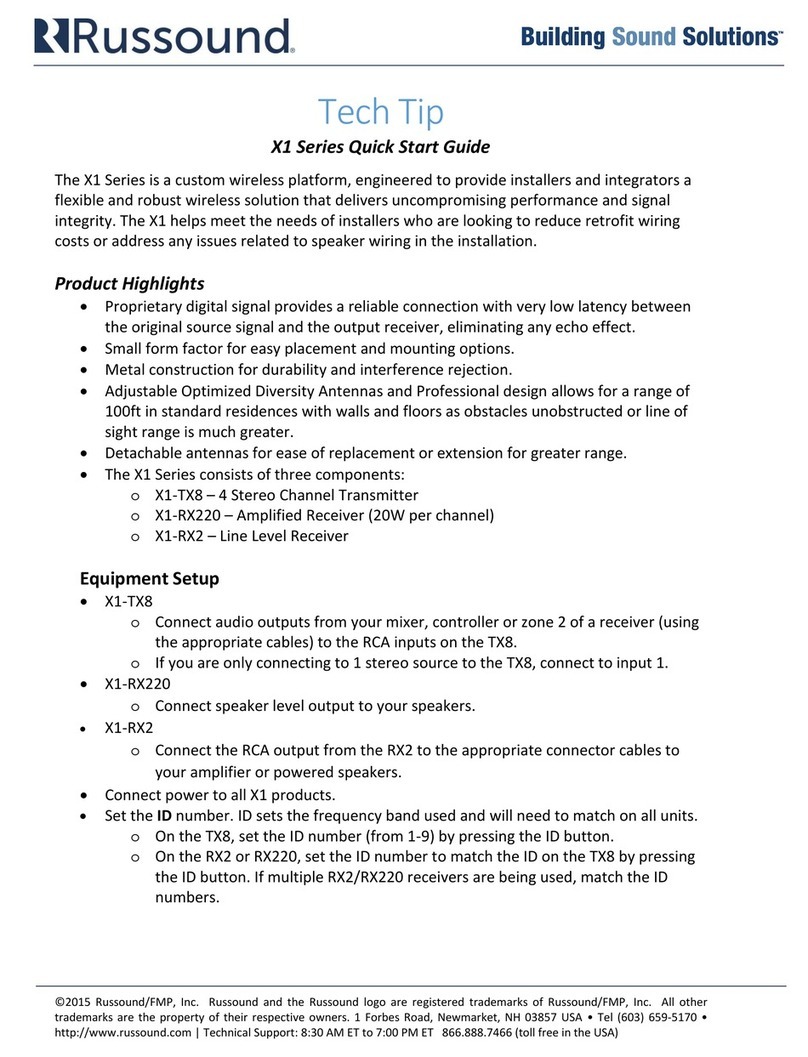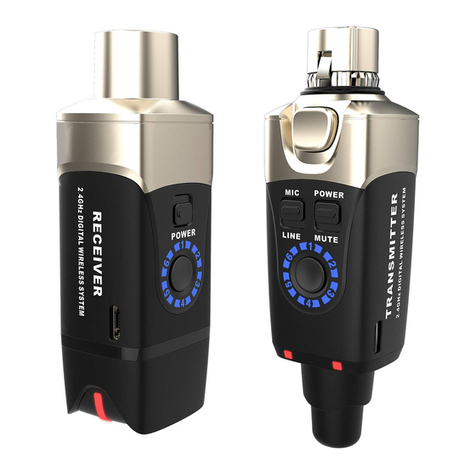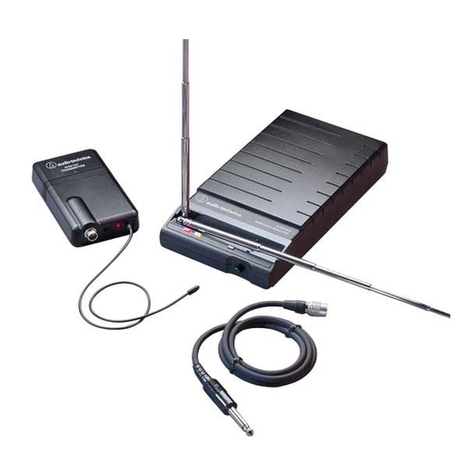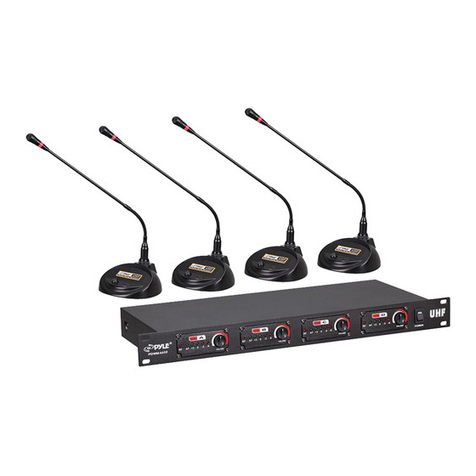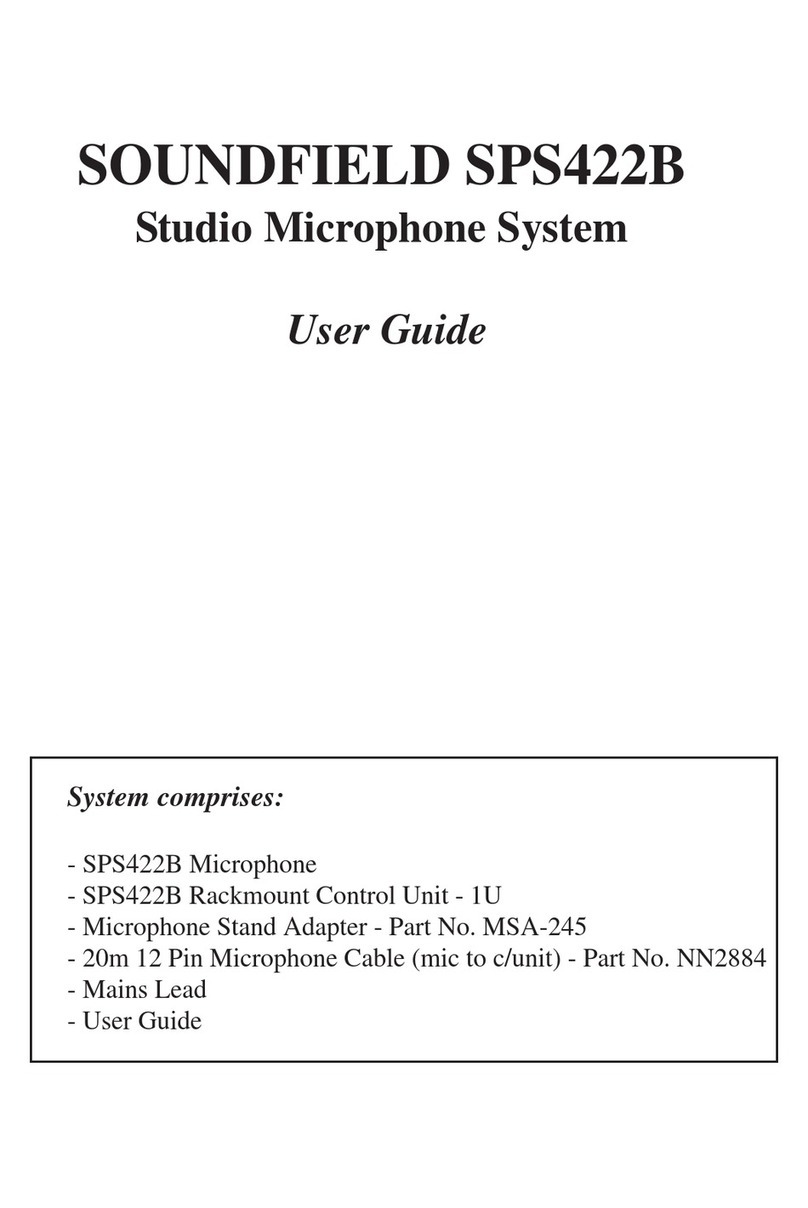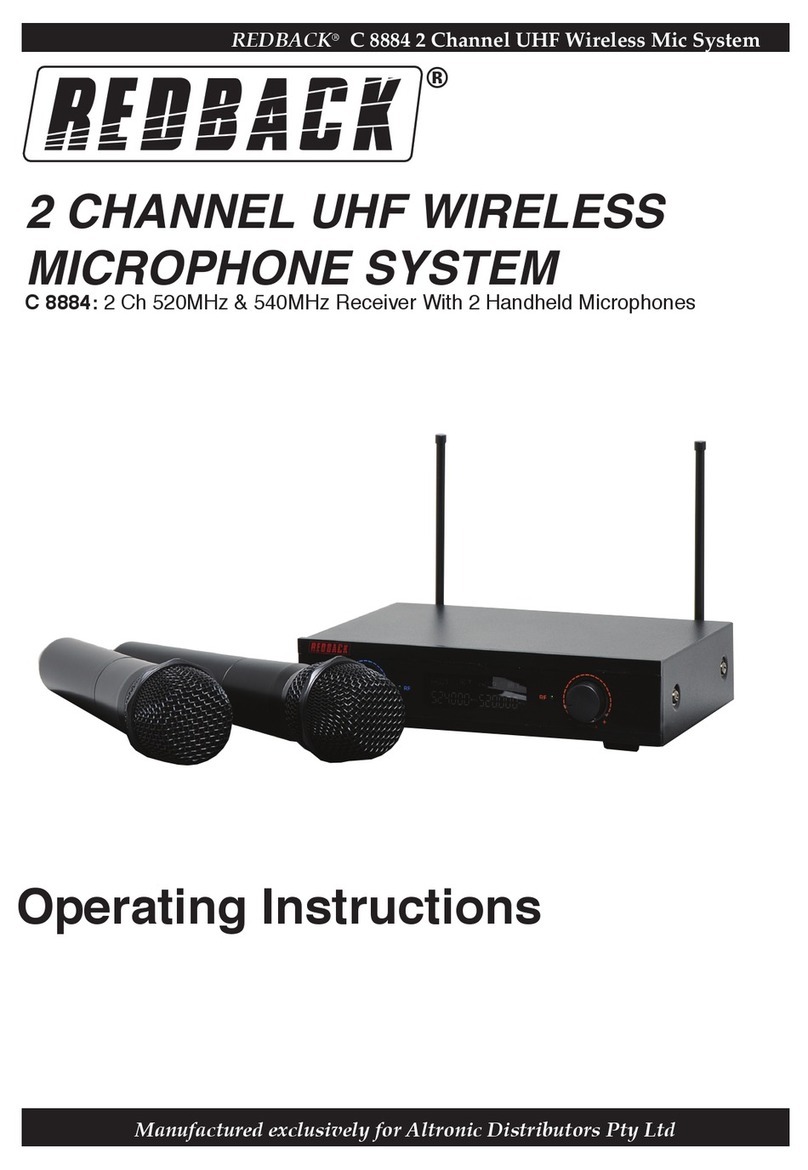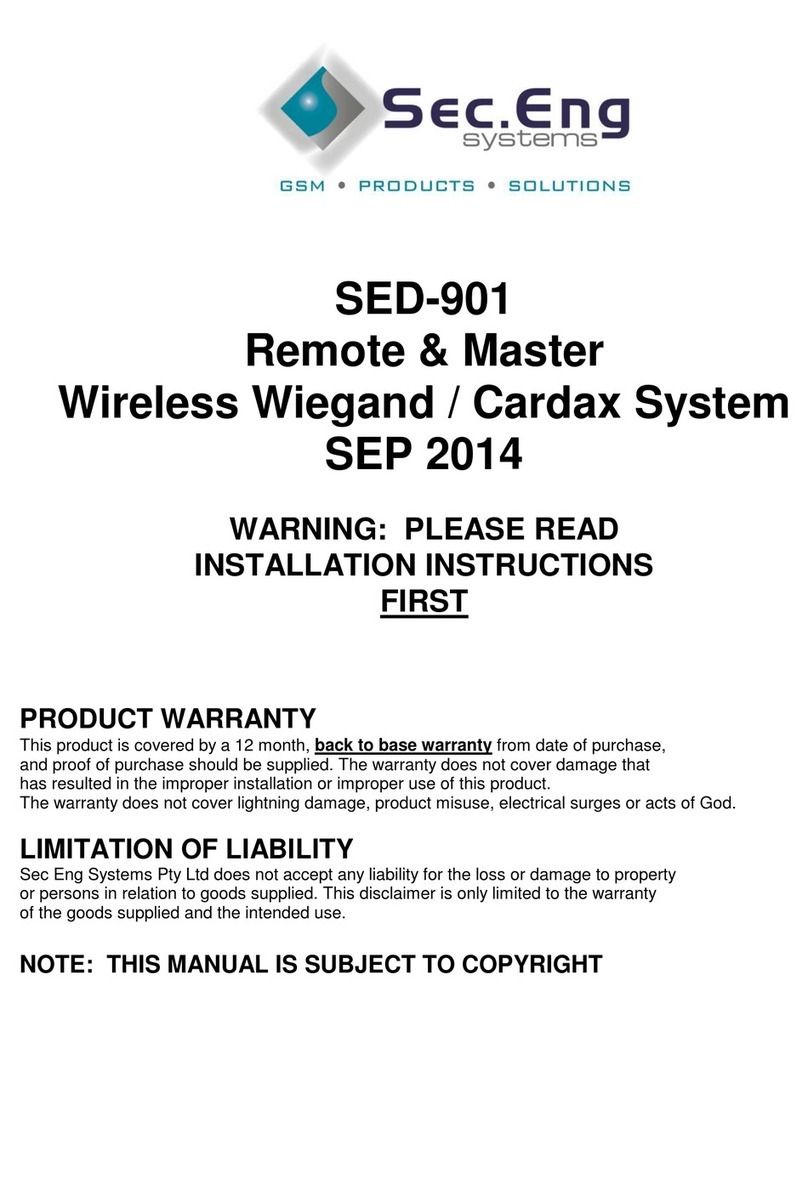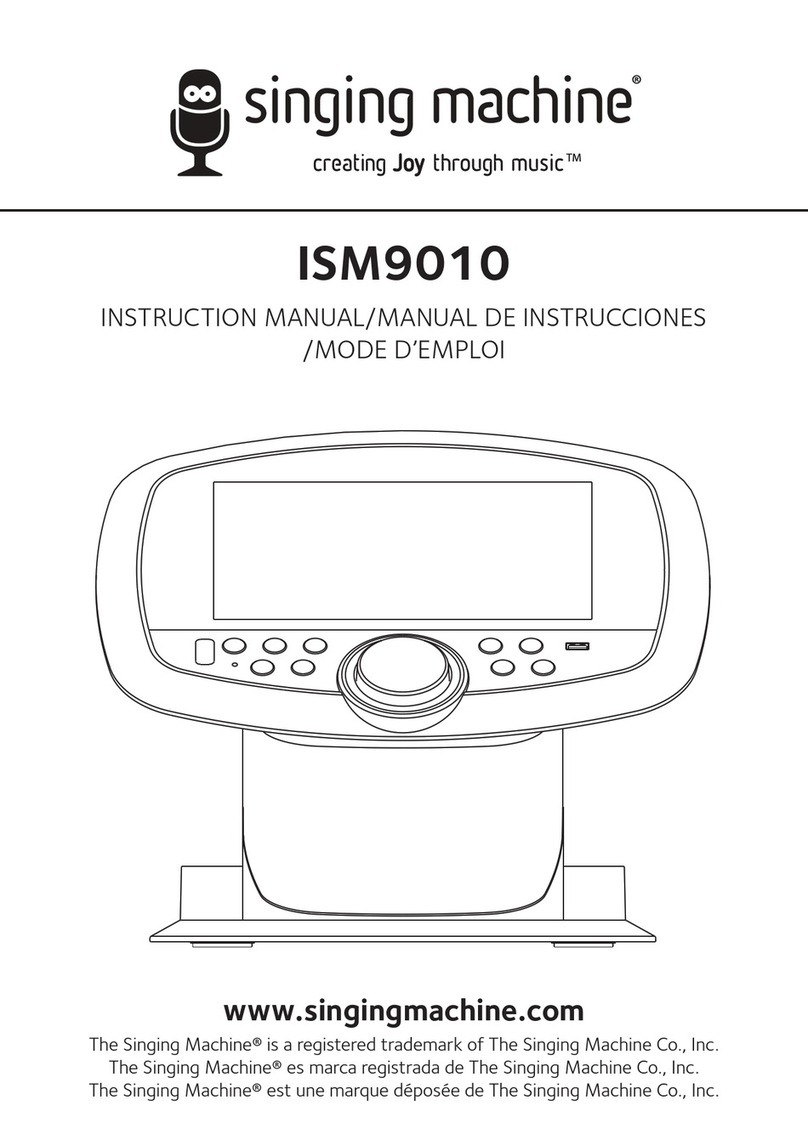Alto Radius 200 User manual


3
User Guide (English)
Introduction
Features
•All-in-one, easy-to-use wireless microphone system for the most demanding professional applications
•Dual-antenna/dual-receiver True Diversity design for mission-critical, dropout-free operation
•UHF band operation (520–937.5 MHz), regionally selected
•Receiver includes a high-visibility back-lit LCD display: Displays RF frequency and channel, AF and RF
signal levels and other critical functions
•Radius 200: Hand-held condenser vocal microphone transmitter with integrated LCD display
•Radius 200H: High-quality headset microphone and wireless belt-pack transmitter
•Radius 200L: High-quality lavalier/lapel microphone with included clip and wireless belt-pack transmitter
•Radius 200M: Wireless belt-pack transmitter and 1/4” (6.35mm) instrument cable
•Single-button scan feature for quickly identifying the optimal operating frequency
•Sync function automatically synchronizes transmitter and receiver frequency
•Squelch control for maximum clarity and dynamic range
•Front-panel rotary volume control
•Balanced XLR and unbalanced 1/4” (6.35 mm) mic- or line-level outputs
Box Contents
Radius 200
Radius 200 Receiver
Radius HHT Condenser Microphone Transmitter
Rackmount and Coupling Brackets (screws included)
1/4” (6.35mm) Unbalanced Audio Cable (3 feet / 1 meter)
2 BNC antennas
Power Adapter
2 AA Batteries
User Guide
Safety & Warranty Manual
Radius 200H
Radius 200 Receiver
Radius HSM Headset Microphone Transmitter
Radius BPT Wireless Belt-Pack Transmitter
Rackmount and Coupling Brackets (screws included)
1/4” (6.35mm) Unbalanced Audio Cable (3 feet / 1 meter)
2 BNC antennas
Power Adapter
2 AA Batteries
User Guide
Safety & Warranty Manual
Radius 200L
Radius 200 Receiver
Radius LVM Lavalier Microphone Transmitter
Radius BPT Wireless Belt-Pack Transmitter
Rackmount and Coupling Brackets (screws included)
1/4” (6.35mm) Unbalanced Audio Cable (3 feet / 1 meter)
2 BNC antennas
Power Adapter
2 AA Batteries
User Guide
Safety & Warranty Manual
Radius 200M
Radius 200 Receiver
Radius BPT Wireless Belt-Pack Transmitter
Rackmount and Coupling Brackets (screws included)
1/4” (6.35mm) Instrument Adapter Cable
1/4” (6.35mm) Unbalanced Audio Cable (3 feet / 1 meter)
2 BNC antennas
Power Adapter
2 AA Batteries
User Guide
Safety & Warranty Manual
Support
For the latest information about this product (system requirements, compatibility information, etc.) and
product registration, visit altoprofessional.com.

4
Important Safety Precautions
Please note: Alto Professional and inMusic are not responsible for the use of its products or
the misuse of this information for any purpose. Alto Professional and inMusic are not
responsible for the misuse of its products caused by avoiding compliance with inspection and
maintenance procedures. Please also refer to the included safety and warranty manual for
more information.
Cables
Make sure your cables are out of the way of performers, production crew, and audience so
they will not trip over them.
Sound Level
Permanent hearing loss may be caused by exposure to extremely high noise levels. The U.S.
Occupational Safety and Health Administration (OSHA) has specified permissible exposures to
certain noise levels. According to OSHA, exposure to high sound pressure levels (SPL) in
excess of these limits may result in hearing loss. When using equipment capable of generating
high SPL, use hearing protection while such equipment is under operation.
Hours per day SPL (dB) Example
8 90 Small gig
6 92 Train
4 95 Subway train
3 97 High level desktop monitors
2 100 Classical music concert
1.5 102 Riveting machine
1 105 Machine factory
0.50 110 Airport
0.25 or less 115 Rock concert

5
Features
Transmitter
Your Radius 200 includes one of the following transmitter systems:
•Radius 200: a hand-held condenser vocal microphone transmitter
•Radius 200H: a headset microphone and wireless belt-pack transmitter
•Radius 200L: a lavalier microphone and wireless belt-pack transmitter
•Radius 200M: a 1/4” (6.35mm) instrument adapter cable and wireless belt-pack transmitter
Condenser Microphone Transmitter (Radius 200)
1. Power/Mute Button: Press this button for 4seconds to power the
transmitter on or off. When the transmitter is on, press this button briefly
to mute or unmute the microphone.
2. Power/Mute LED: This light indicates the power or mute status:
•Red light: The transmitter is on.
•Flashing red light: The transmitter is low on battery power.
•Blue light: The transmitter is muted.
•Flashing blue light: The transmitter is muted and low on battery
power.
3. Sync Button: Press this button to synchronize the transmitter with the
receiver. See Operation to learn more.
4. Display: This display shows the current channel and battery power level.
5. Battery Compartment (not pictured): Insert 2 AA batteries into the
compartment. Make sure the polarities of the batteries (+and –) are
correct.
6. Grille: This mesh protects the microphone capsule and reduces noise
from air and breath.
6
4
3
5
2
1

6
Belt-Pack Transmitter (for Radius 200H headset, Radius 200L lavalier microphone, or
Radius 200M instrument cable)
1. Power/Mute Button: Press this button for 2seconds to power
the transmitter on or off. Press this button briefly to mute or
unmute the transmitter.
2. Power/Mute LED: This light indicates the power or mute status:
•Red light: The transmitter is on.
•Flashing red light: The transmitter is low on battery
power.
•Blue light: The transmitter is muted.
•Flashing blue light: The transmitter is muted and low on
battery power.
3. Sync Button: Press this button to synchronize the transmitter
with the receiver. See Operation to learn more.
4. Display: This display shows the current channel and battery
power level.
5. Battery Compartment (not pictured): Insert 2 AA batteries into
this compartment. Make sure the polarities of the batteries (+and
–) are correct.
6. Microphone/Instrument Input (mini-XLR): Connect the included
microphone or instrument cable to this input.
7. Gain Selector: Use this switch to set the gain of the audio input
to 10 dB, 0 dB, or -10 dB. For instruments with passive pickups,
we recommend setting this to -10 dB. For instruments with active
pickups, you may want to set this to 0 dB or -10 dB.
Receiver
Front Panel
POWER
126
34
5
1. Power Button: Press this button to power the receiver on or off.
2. Display: This display shows the current channel, frequency, and other settings. See Display for
more information.
3. Up/Down (): Press one of these buttons to select the different modes (Manual, Autoscan,
Preset). When searching for channels, press one of these buttons to move to the next-highest or
next-lowest channel, respectively.
4. Sync: Press this button to synchronize the receiver with the transmitter. See Operation to learn
more.
5. Set: Press this button to confirm your mode selection (Manual, Autoscan, Preset) or to set the
current channel. See Operation to learn more.
6. Volume Knob: Turn this knob to adjust the receiver’s output level.
16
4
2
3
7
5
1: Ground
2: Line In
3: Mic In
4: +10V
1: Ground
2: Line In
3: Mic In
4: +10V
Mic Level
Line Level
3 4 1
2

7
Display
MANUAL
GP CH
SCAN
PRESET
SYNC
CH
MUTE
RF AF
FREQ MHz
P1 P2 P3 P4 1 2 3 4 5 6 7 8
15
7
62
34
10 11
9
8
1. Manual: This indicator appears when the receiver is in Manual Mode, where you can select
the channel manually. Use the Up/Down buttons to cycle between the different modes.
2. Scan: This indicator appears when the receiver is in Autoscan Mode, where the receiver
automatically selects the channel with the clearest and strongest reception.
3. Preset: This indicator appears when the receiver is in Preset Mode, where you can select
a Preset group of channels rather than having to scan the entire frequency band.
4. Sync: This indicator appears when the transmitter and receiver are synchronized.
5. GP (P1, P2, P3, P4): This is the current Preset group.
6. CH (1–8): This is the current Preset Channel.
7. CH (region-specific): This is the current channel number. The number of available
channels depends on your region.
8. Freq: This is the current frequency in MHz.
9. Mute: This indicator appears when the audio signal is muted.
10. RF: This meter shows the current level of reception between the transmitter and receiver.
11. AF: This meter shows the current audio signal level sent from the receiver’s audio outputs.
Rear Panel
11
2
6
345
1. Antenna Terminal: Connect the included antennae to these terminals.
2. Audio Output (XLR): Use a standard XLR cable to connect this balanced output to your
guitar amplifier, mixer, PA system, etc.
3. Audio Output (1/4” / 6.35 mm): Use a standard 1/4” (6.35 mm) cable to connect this
unbalanced output to your mixer, PA system, etc.
4. Line/Mic Selector: Use this switch to select whether the signal from the receiver’s output
is line-level or microphone-level. Set this switch to Line if you are connecting it to a
balanced line-level input (e.g., a mixer’s XLR or 1/4” TRS input) or an instrument amplifier’s
low-impedance active instrument input. Set this switch to Mic if you are connecting it to
an instrument amplifier’s high-impedance instrument-level input.
5. Squelch: Turn this knob to adjust the noise floor level.
6. Power Input: Use the included power adapter (12 V, 1 A, center positive) to connect this
input to your power source.

8
Operation
To set up and use your Radius 200, follow the steps in this chapter in order. If you are setting
up a system using multiple receiver-transmitter pairs, set up each pair one at a time, and keep
each pair powered on as you set up others.
1. Set Up the Receiver
Optional: Connect Rackmount Pieces and/or Antennas
To use two receivers in a standard 19”
rack, use the included rackmount
brackets, coupling brackets, and
screws.
To use one receiver in a standard 19”
rack, use two long rackmount brackets
(sold separately) and screws.
We highly recommend using the
included antennas to improve and
strengthen reception.
You can also use an antenna booster
(sold separately) to further enhance the
signal.
Rackmount
bracket
Rackmount
bracket
Coupling
bracket
Coupling
bracket
Receiver
Receiver
Receiver
Long
rackmount
bracket
Long
rackmount
bracket
Receiver
Antenna Antenna
Antenna
booster
Antenna
booster

9
Set Up the Receiver’s Connections, Mode, and Channel
1. Use the included power adapter to connect the receiver's power input to your power source.
The receiver will power on automatically.
2. Use a standard XLR cable or 1/4” (6.35mm) to connect one of the receiver’s audio outputs to
your mixer or amplifier system. Do not use both audio outputs at the same time; this can result
in signal loss or increased noise.
3. Set the Line/Mic Selector to the appropriate setting:
•Set this switch to Line if you are connecting it to a balanced line-level input (e.g., a mixer’s
XLR or 1/4” (6.35mm) TRS input) or an instrument amplifier’s low-impedance active
instrument input.
•Set this switch to Mic if you are connecting it to an instrument amplifier’s high-impedance
instrument-level input.
4. Set the receiver’s channel using one of the following methods:
•Manual Mode
Important: Do not place two or more transmitters within range of the receiver when
selecting a channel. Also, keep the transmitter at least 3feet (1meter) away from the
receiver.
i. Use the receiver’s Up or Down buttons to select Manual Mode. (You must press
and hold each button for approximately 1second to switch to the next mode.)
ii. Press and hold the Set button for approximately 1second. The display’s numbers
will flash.
iii. Use the Up/Down buttons to select a channel.
iv. Press the Set button to lock the reception to that channel.
•Autoscan Mode
Important: If you are setting up a system using multiple receiver-transmitter pairs, keep
each pair powered on as you set up others. This will prevent each pair from automatically
selecting the same channel.
i. Use the receiver’s Up or Down buttons to select Autoscan Mode (Auto). (You
must press and hold each button for approximately 1second to switch to the next
mode.)
ii. Press and hold the Set button for approximately 1second. The display’s numbers
will flash.
iii. Press the Up or Down button once. The receiver will automatically scan
frequencies and select the first channel with strong, clear reception.
iv. Press the Set button to lock the reception to that channel.
•Preset Mode
i. Use the receiver’s Up or Down buttons to select Preset Mode. (You must press
and hold each button for approximately 1second to switch to the next mode.)
ii. Press and hold the Set button for approximately 1second. The display’s numbers
will flash.
iii. Use the Up/Down buttons to select a Preset group (P1, P2, P3, or P4).
iv. Press the Set button to lock the reception to that Preset group.
v. Use the Up/Down buttons to select a channel in that Preset group.
vi. Press the Set button to lock the reception to a channel in that Preset group.
Important: If there is any interference on the current Preset group’s channels, repeat
Steps iii–vi.

10
2. Set Up the Transmitter
Condenser Vocal Microphone Transmitter:
1. Remove the transmitter’s battery compartment cover and insert 2 AA batteries into the
compartment. Make sure the polarities of the batteries (+and –) are correct.
2. Reattach battery compartment cover to the transmitter.
3. Press the transmitter’s Power Button for 4seconds to power the transmitter on or off.
Wireless Belt-Pack Transmitter:
1. Remove the transmitter’s battery compartment door and insert 2 AA batteries into the
compartment. Make sure the polarities of the batteries (+and –) are correct.
2. Press the transmitter’s Power Button for 2seconds to power the transmitter on or off.
3. Synchronize the Receiver and Transmitter
1. Make sure the receiver and transmitter are within 3feet (1meter) from each other and
powered on.
2. Press and hold the Sync button on the transmitter until Sync flashes in the receiver’s
display.
3. Press the Sync button on the receiver.
4. Adjust Your Levels and Settings
Gain Level: If you are using a wireless belt-pack transmitter, set its Gain Selector to 10 dB,
0 dB, or -10 dB to set the gain of the audio input.
Volume Level: Use the receiver’s Volume Knob to set the audio signal level sent from the
receiver’s audio output to your mixer or amplifier system.
Squelch Level: Use the Squelch Knob to adjust the noise floor level, minimizing background
or ambient noise during silent moments. Higher settings allow for greater noise reduction and
dynamic range, but a setting that’s too high can cause intentionally quieter sounds to be
silenced along with the noise. Be sure to experiment with different settings to find an optimal
balance.

11
Troubleshooting
Problem Solution
The receiver does not
produce any sound.
Make sure the receiver’s power adapter is properly
connected to the power input and a power source.
Make sure the transmitter’s batteries are properly inserted
and that their polarities (+and –) are correct.
Make sure the transmitter and receiver are set to the same
frequency.
Make sure the receiver’s audio output is properly connected
to your mixer, amplifier system, etc.
Make sure the receiver and transmitter are within 328 feet
(100 meters) and have a clear line of sight. Also, make sure
the receiver is not immediately near any metal objects or
devices that could cause RF interference (other wireless
systems, TVs, radio, etc.).
Lower the setting of the receiver’s Squelch knob.
There is audible interference
in the transmission.
Make sure the receiver and transmitter are within 328 feet
(100 meters) and have a clear line of sight. Also, make sure
the receiver is not immediately near any metal objects or
devices that could cause RF interference (other wireless
systems, TVs, radio, etc.).
Make sure the receiver’s antennae are properly attached to
its antenna terminals.
If you are using multiple transmitter-receiver pairs, make sure
the pairs are not using the same or adjacent frequencies.
The signal is distorted. Make sure the receiver is not immediately near any metal
objects or devices that could cause RF interference (other
wireless systems, TVs, radio, etc.).
Lower the setting of the receiver’s Volume knob.

12
Guía del usuario (Español)
Introducción
Características
•Sistema de micrófono inalámbrico para las aplicaciones profesionales más exigentes, todo en uno y fácil
de utilizar
•Diseño de diversidad verdadera de doble antena/doble receptor para un desempeño de misión crítica
sin cortes
•Operación en banda UHF (520–937,5 MHz), seleccionable según la región
•El receptor incluye una pantalla LCD retroiluminada de alta visibilidad: Muestra la frecuencia y canal de
RF (radiofrecuencia), los niveles de las señales AF (volumen del audio) y RF y otras funciones críticas
•Radius 200: Transmisor de mano para micrófono de voz condensador con pantalla LCD integrada
•Radius 200H: Micrófono de alta calidad con auricular y transmisor inalámbrico para cinturón
•Radius 200L: Micrófono de corbata/solapa de alta calidad con clip incluido y transmisor inalámbrico
para cinturón
•Radius 200M: Cable de instrument de 6,35mm (1/4 pulg.) y transmisor inalámbrico para cinturón
•Característica de búsqueda de un solo botón para una rápida identificación de la frecuencia de
operación óptima
•Su función de sincronización automática sincroniza la frecuencia en el transmisor y el receptor
•Control del silenciamento de ruido para una claridad y rango dinámico máximos
•Control de volumen giratorio en el panel frontal
•Salidas de nivel de línea o de micrófono de 6,35mm (1/4 pulg.) XLR balanceadas o no balanceadas
Contenido de la caja
Radius 200
Receptor Radius 200
Transmisor de micrófono condensador Radius HHT
Soportes de acoplamiento y para montaje en rack (tornillos incluidos)
Cable de audio no balanceado de 6,35mm (1/4 pulg.) (1 m / 3 pies)
2 antenas BNC
Adaptador de corriente
2 pilas AA
Guía del usuario
Manual sobre la seguridad y garantía
Radius 200H
Receptor Radius 200
Transmisor de micrófono con auricular Radius HSM
Transmisor inalámbrico para cinturón Radius BPT
Soportes de acoplamiento y para montaje en rack (tornillos incluidos)
Cable de audio no balanceado de 6,35mm (1/4 pulg.) (1 m / 3 pies)
2 antenas BNC
Adaptador de corriente
2 pilas AA
Guía del usuario
Manual sobre la seguridad y garantía
Radius 200L
Receptor Radius 200
Transmisor de micrófono de solapa/corbata Radius LVM
Transmisor inalámbrico para cinturón Radius BPT
Soportes de acoplamiento y para montaje en rack (tornillos incluidos)
Cable de audio no balanceado de 6,35mm (1/4 pulg.) (1 m / 3 pies)
2 antenas BNC
Adaptador de corriente
2 pilas AA
Guía del usuario
Manual sobre la seguridad y garantía
Radius 200M
Receptor Radius 200
Transmisor inalámbrico para cinturón Radius BPT
Soportes de acoplamiento y para montaje en rack (tornillos incluidos)
Cable adaptador TS para instrumentos de 6,35mm (1/4 pulg.)
Cable de audio no balanceado de 6,35mm (1/4 pulg.) (1 m / 3 pies)
2 antenas BNC
Adaptador de corriente
2 pilas AA
Guía del usuario
Manual sobre la seguridad y garantía
Soporte
Para obtener la información más completa acerca de este product (los requisitos del sistema,
compatibilidad, etc) y registro del producto, visite altoprofessional.com.

13
Precauciones importantes para la seguridad
Para tener en cuenta: Alto Professional e inMusic no son responsables del uso de sus
productos o el mal uso de esta información para cualquier propósito. Alto Professional e
inMusic no son responsables del mal uso de sus productos causados por la omisión del
cumplimiento de los procedimientos de inspección y mantenimiento. Para más información,
consulte también el manual de seguridad y garantía incluido.
Cables
Asegúrese de que los cables estén fuera del camino de los intérpretes, personal de
producción y audiencia, de modo que no tropiecen con ellos.
Nivel de sonido
La exposición a niveles muy altos de ruido puede causar pérdidas auditivas permanentes. La
Administración de Seguridad y Salud Ocupacional de EE.UU. (OSHA) ha especificado los
niveles de exposición permisibles a ciertos niveles de ruido. Según la OSHA, la exposición a
niveles de presión sonora (SPL) elevados que excedan estos límites puede causar pérdidas
auditivas. Cuando utilice equipos capaces de generar SPL elevados, use protecciones
auditivas mientras dichos equipos están en funcionamiento.
Horas diarias SPL (dB) Ejemplo
8 90 Música de bajo volumen
6 92 Tren
4 95 Tren subterráneo
3 97 Monitores de escritorio de alto nivel
2 100 Concierto de música clásica
1,5 102 Remachadora
1 105 Máquina fabril
0,50 110 Aeropuerto
0,25 o menos 115 Concierto de rock

14
Características
Transmisor
Su Radius 200 incluye uno de los siguientes sistemas de transmisión:
•Radius 200: un transmisor para micrófono de voz condensador de mano
•Radius 200H: un micrófono con auricular ytransmisor inalámbrico para cinturón
•Radius 200H: un micrófono de corbata/solapa y un transmisor inalámbrico para cinturón
•Radius 200M: un cable de instrument de 6,35mm y transmisor inalámbrico para cinturón
Transmisor de micrófono condensador (Radius 200)
1. Botón de encendido/silenciamiento: Mantenga pulsado este botón 4
segundos para encender o apagar el transmisor. Cuando el transmisor
está encendido, pulse este botón brevemente para silenciar o anular el
silenciamiento del micrófono.
2. LED de encendido/silenciamiento: Esta luz indica el estado del
encendido o silenciamiento:
•Luz roja: El transmisor está encendido.
•Luz roja parpadeante: La pila del transmisor se está agotando.
•Luz azul: El transmisor está silenciado.
•Luz azul parpadeante: La pila del transmisor se está agotando y el
transmisor silenciado.
3. Botón Sync (Sincronización):Pulse este botón para sincronizar el
transmisor con el receptor. Consulte Funcionamiento para aprender
más.
4. Pantalla: Esta pantalla muestra el canal y el nivel de carga de las pilas
actuales.
5. Compartimiento de las pilas (no se muestra): Inserte 2 pilas AA en el
compartimiento. Asegúrese de que las polaridades de las pilas (+y –) sea
la correcta.
6. Rejilla: Esta malla protege la cápsula del micrófono y reduce el ruido del
aire y la respiración.
6
4
3
5
2
1

15
Transmisor para cinturón
(para micrófono con auricular [Radius 200H], micrófono de corbata/solapa [Radius 200L] o cable de
instrument [Radius 200M])
1. Botón Power/Mute (Encendido/silenciamiento):Mantenga pulsado
este botón 2segundos para encender o apagar el transmisor.
Pulse este botón brevemente para silenciar o anular el
silenciamiento del transmisor.
2. LED de encendido/silenciamiento: Esta luz indica el estado del
encendido o silenciamiento:
•Luz roja: El transmisor está encendido.
•Luz roja destellante: La pila del transmisor se está agotando.
•Luz azul: El transmisor está silenciado.
•Luz azul parpadeante: La pila del transmisor se está agotando
y el transmisor silenciado.
3. Botón Sync (Sincronización):Pulse este botón para sincronizar el
transmisor con el receptor. Consulte Funcionamiento para
aprender más.
4. Pantalla: Esta pantalla muestra el canal y el nivel de carga de las
pilas actuales.
5. Compartimiento de las pilas (no se muestra): Inserte 2 pilas AA
en este compartimiento. Asegúrese de que las polaridades de las
pilas (+y –) sea la correcta.
6. Entrada del micrófono/instrumento (mini XML de 4 patillas):
Conecte a esta entrada el micrófono o el cable para instrumentos
incluido.
7. Selector de ganancia: Utilice este interruptor para ajustar la
ganancia de esta entrada de audio a 10 dB, 0 dB o -10 dB. Para
instrumentos con captadores pasivos, recomendamos ajustar
esto a -10 dB. Para instrumentos con captadores activos,
recomendamos ajustar esto a 0o -10 dB.
Receptor
Panel frontal
POWER
126
34
5
1. Botón de encendido: Pulse este botón para encender o apagar el receptor.
2. Pantalla: Esta pantalla muestra el canal, la frecuencia y demás ajustes actuales. Consulte
Pantalla para más información.
3. Subir/bajar (): Pulse uno de estos botones para seleccionar los modos diferentes (Manual,
Autoscan (Búsqueda automática), o Preset (Predefinido)). Al buscar canales, pulse uno de los
botones para moverse al próximo canal superior o inferior respectivamente.
4. Sync (Sincronización):Pulse este botón para sincronizar el receptor con el transmisor. Consulte
Funcionamiento para aprender más.
5. Set (Ajustar):Pulse este botón para confirmar su selección de modo (Manual, Autoscan
(Búsqueda automática), o Preset (Predefinido)) o para ajustar el canal actual.
6. Perilla de volumen: Gire esta perilla para ajustar el volumen de salida del receptor.
16
4
2
3
7
5
Nivel de micrófono
Nivel de línea
1: Tierra
2: Línea
3: Micrófono
4: +10V
1: Tierra
2: Línea
3: Micrófono
4: +10V
3 4 1
2

16
Pantalla
MANUAL
GP CH
SCAN
PRESET
SYNC
CH
MUTE
RF AF
FREQ MHz
P1 P2 P3 P4 1 2 3 4 5 6 7 8
15
7
62
34
10 11
9
8
1. Manual: Este indicador aparece cuando el receptor se encuentra en modo Manual, en el cual
usted podrá seleccionar el canal manualmente.Utilice los botones subir/bajar () para
alternar entre los diferentes modos.
2. Scan (Búsqueda):Este indicador aparece cuando el receptor se encuentra en modo Autoscan,
en el cual el receptor selecciona automáticamente el canal con la recepción más fuerte y clara.
3. Preset: Este indicador aparece cuando el receptor se encuentra en modo Preset, en el cual
usted podrá seleccionar un grupo de canales predefinidos en lugar de tener que recorrer toda la
banda de frecuencias.
4. Sync (Sincronización):Este indicador aparece cuando el transmisor y el receptor están
sincronizados.
5. GP (P1, P2, P3, P4): El grupo predefinido actual.
6. CH (1–8): El canal predefinido actual.
7. CH (específico para cada región): El número del canal actual. La cantidad de canales
disponibles depende de su región.
8. Freq (Frecuencia):La frecuencia actual en MHz.
9. Mute (Silenciar):Este indicador aparece cuando la señal de audio está silenciada.
10. RF (Radiofrecuencia):Este medidor muestra el nivel de recepción actual entre el transmisor y el
receptor.
11. AF (Volumen del audio):Este medidor muestra el nivel de la señal de audio actual enviado desde
las salidas de audio del receptor.
Panel trasero
11
2
6
345
1. Terminal de la antena: Conecte a estos terminales las antenas incluidas.
2. Salida de audio (XLR): Utilice un cable XLR estándar para conectar esta salida balanceada a su
mezclador, sistema de altavoces alimentados, etc.
3. Salida de audio (1/4 pulg. / 6,35 mm): Utilice un cable estándar de 1/4 pulg. / 6,35 mm para
conectar esta salida no balanceada a su amplificador de guitarra, mezclador, sistema de
altavoces alimentados, etc.
4. Selector Line/Mic (Línea/micrófono):Utilice este interruptor para indicar si la señal proveniente
de la salida del receptor es de nivel de línea o de nivel de micrófono. Coloque este interruptor a
Line si lo está conectando a una entrada de nivel de línea balanceada (por ej., la entrada XLR o TRS
de 6,35 mm (1/4 pulg.) de un mezclador) o una entrada activa para instrumentos de baja impedancia
de un amplificador de instrumento. Ajuste este interruptor a Mic si lo está conectando a una
entrada de nivel de instrumentos de alta impedancia de un amplificador de instrumento.
5. Silenciador de ruido: Gire esta perilla para ajustar el nivel del piso de ruido.
6. Entrada de corriente: Utilice el adaptador de corriente incluido (12 V, 1 A, centro positivo) para
conectar esta entrada a su fuente de corriente.

17
Funcionamiento
Para instalar y utilizar su Radius 200, siga los pasos en este capítulo en orden. Si está
instalando un sistema con múltiples pares de receptores-transmisores, instale de a un par a la
vez, y mantenga cada par encendido a medida que instala los otros.
1. Instale el receptor
Opcional: Conecte las piezas y/o antenas para montaje en rack
Utilice dos receptores en un rack
estándar de 19 pulg., utilice los
soportes, los soportes de acoplamiento
y los tornillos para montaje en rack
incluidos.
Para utilizar un receptor en un rack
estándar de 19 pulg., utilice dos
soportes largos para montaje en rack
(que se venden por separado) y
tornillos.
Recomendamos especialmente utilizar
las antenas incluidas para mejorar y
reforzar la recepción.
También puede utilizar un amplificador
de antena (que se vende por separado)
para mejorar la señal aún más.
Soporte
para rack
Soporte
para rack
Soporte de
acoplamiento
Soporte de
acoplamiento
Receptor
Receptor
Receptor
Soporte
largo
para rack
Soporte
largo
para rack
Receptor
Antena Antena
Amplificador de antenaAmplificador de antena

18
Configure las conexiones, el modo y el canal del receptor
1. Utilice el adaptador de corriente incluido para conectar la entrada de corriente del receptor a
su fuente de corriente. El receptor se encenderá automáticamente.
2. Utilice un cable XLR o de 1/4 pulg. (6,35 mm) estándar para conectar una de las salidas de
audio de su receptor a su mezclador o sistema de amplificación. No utilice ambas salidas de
audio al mismo tiempo; esto puede dar como resultado una pérdida en la señal o mayor ruido.
3. Coloque el selector Line/Mic (Línea/Micrófono) en la posición apropiada:
•Coloque este interruptor a Line si lo está conectando a una entrada de nivel de línea
balanceada (por ej., la entrada XLR o TRS de 6,35 mm (1/4 pulg.) de un mezclador) o una
entrada activa para instrumentos de baja impedancia de un amplificador de instrumento.
•Ajuste este interruptor a Mic si lo está conectando a una entrada de nivel de instrumentos
de alta impedancia de un amplificador de instrumento.
4. Ajuste el canal del receptor mediante uno de los siguientes métodos:
•Modo manual
Importante: No coloque dos o más transmisores dentro del alcance del receptor al
seleccionar un canal. Además, mantenga el transmisor al menos a 3pies (1 metro) de
distancia del receptor.
i. Utilice los botones subir o bajar del receptor para seleccionar el modo Manual.
(Debe de mantener pulsado cada botón durante aproximadamente 1segundo para
pasar al siguiente modo).
ii. Mantenga pulsado el botón Set (Ajustar) durante aproximadamente 1segundo. Los
números en la pantalla parpadearán.
iii. Utilice los botones de flechas hacia arriba y abajo para seleccionar un canal.
iv. Pulse el botón Set para fijar la recepción a ese canal.
•Modo de búsqueda automática
Importante: Si está instalando un sistema con múltiples pares de receptores-
transmisores mantenga cada par encendido a medida que instala los otros. Esto evitará
que cada par seleccione automáticamente el mismo canal.
i. Utilice los botones subir o bajar del receptor para seleccionar el modo Autoscan
(Búsqueda automática, Auto). (Debe de mantener pulsado cada botón durante
aproximadamente 1segundo para pasar al siguiente modo).
ii. Mantenga pulsado el botón Set (Ajustar) durante aproximadamente 1segundo. Los
números en la pantalla parpadearán.
iii. Pulse el botón de flecha hacia arriba o abajo una vez. El receptor buscará
frecuencias de forma automática y seleccionará el primer canal con una recepción
fuerte y clara.
iv. Pulse el botón Set para fijar la recepción a ese canal.
•Modo preset (predefinido)
i. Utilice los botones subir o bajar del receptor para seleccionar el modo Preset
(Predefinido). (Debe de mantener pulsado cada botón durante aproximadamente 1
segundo para pasar al siguiente modo).
ii. Mantenga pulsado el botón Set (Ajustar) durante aproximadamente 1segundo. Los
números en la pantalla parpadearán.
iii. Utilice los botones de flecha hacia arriba o abajo para seleccionar un grupo
predefinido (P1, P2, P3 o P4).
iv. Pulse el botón Set para fijar la recepción a ese canal.
v. Utilice los botones de flechas hacia arriba y abajo para seleccionar un canal en ese
grupo predefinido.
vi. Pulse el botón Set para fijar la recepción a ese canal en ese grupo predefinido.
Importante: Si existe interferencia en los canales del grupo predefinido actual, repita los
pasos iii–vi.

19
2. Instale el transmisor
Transmisor para micrófono de voz condensador:
1. Extraiga la puerta del compartimiento para pilas del transmisor e inserte 2 pilas AA en el
mismo. Asegúrese de que las polaridades de las pilas (+y –) sea la correcta.
2. Vuelva la puerta del compartimiento para pilas del transmisor.
3. Mantenga pulsado el botón de encendido del transmisor durante 4segundos para
encenderlo o apagarlo.
Transmisor inalámbrico para cinturón:
1. Extraiga la puerta del compartimiento para pilas del transmisor e inserte 2 pilas AA en el
mismo. Asegúrese de que las polaridades de las pilas (+y –) sea la correcta.
2. Mantenga pulsado el botón de encendido del transmisor durante 2segundos para
encenderlo o apagarlo.
3. Sincronice el receptor y el transmisor
1. Asegúrese de que el receptor y el transmisor estén encendidos y a menos de 3pies (1
metro) de distancia entre sí.
2. Mantenga pulsado el botón Sync (Sincronización) del transmisor hasta que parpadee
Sync en la pantalla del receptor.
3. Pulse el botón Sync del receptor.
4. Ajuste sus niveles y configuraciones
Nivel de ganancia: Si está utilizando un transmisor inalámbrico para cinturón, ajuste su selector
Gain (Ganancia) a 10 dB, 0 dB o -10 dB para ajustar la ganancia de la entrada de audio.
Nivel de volumen: Utilice la perilla de volumen del receptor para ajustar el nivel de la señal de
audio enviada desde la salida de audio del receptor a su mezclador o sistema de amplificación.
Nivel del silenciador de ruido: Utilice la perilla del silenciador de ruido para ajustar el nivel
del piso de ruido, minimizando el ruido de fondo o ambiente durante los momentos de
silencio. Los ajustes más altos permiten una mayor reducción del ruido y rango dinámico,
pero un ajuste demasiado alto puede causar que los sonidos intencionalmente más leves sean
silenciados junto con el ruido. Asegúrese de experimentar con diferentes ajustes para
encontrar un balance óptimo.

20
Solución de problemas
Problema Solución
El receptor no produce
ningún sonido.
Asegúrese de que el adaptador de corriente del receptor esté
conectado correctamente a la entrada de corriente y a la fuente
de corriente.
Asegúrese de que las pilas del transmisor estén insertadas
apropiadamente y que sus polaridades (+y –) sean correctas.
Asegúrese de que tanto el transmisor como el receptor estén
sintonizados a la misma frecuencia.
Asegúrese de que la salida de audio del receptor esté
conectada correctamente a su mezclador, sistema de
amplificación, etc.
Asegúrese de que el receptor y el transmisor estén encendidos y
a menos de 328 pies (100 metros) de distancia entre sí y en línea
de visión directa. Además, asegúrese de que el receptor no esté
inmediatamente cerca de ningún objeto o dispositivo metálico
que pudiera causar interferencia de RF (otros sistemas
inalámbricos, TV, radio, etc.).
Disminuya el ajuste de la perilla del silenciador de ruido del
receptor.
Se escucha interferencia en
la transmisión.
Asegúrese de que el receptor y el transmisor estén encendidos y
a menos de 328 pies (100 metros) de distancia entre sí y en línea
de visión directa. Además, asegúrese de que el receptor no esté
inmediatamente cerca de ningún objeto o dispositivo metálico
que pudiera causar interferencia de RF (otros sistemas
inalámbricos, TV, radio, etc.).
Asegúrese de que las antenas del receptor estén conectadas
correctamente a sus terminales de antena.
Si está utilizando múltiples pares de transmisores-receptores,
asegúrese de que los pares no estén en la misma frecuencia o
en frecuencias adyacentes.
La señal está distorsionada. Asegúrese de que el receptor no esté inmediatamente cerca de
ningún objeto o dispositivo metálico que pudiera causar
interferencia de RF (otros sistemas inalámbricos, TV, radio, etc.).
Disminuya el ajuste de la perilla de volumen del receptor.
This manual suits for next models
3
Table of contents
Languages:
Other Alto Microphone System manuals

Alto
Alto Radius 100 User manual
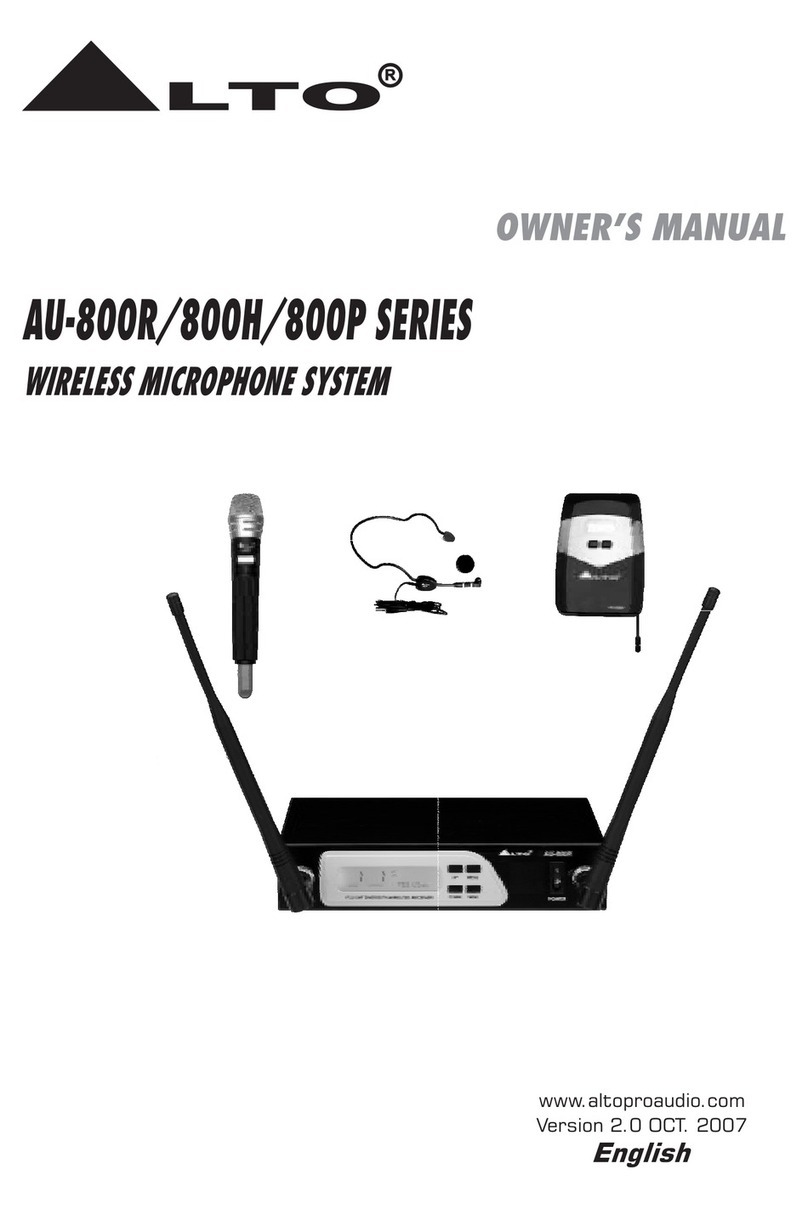
Alto
Alto AU-800R Series User manual

Alto
Alto MOD-800R User manual
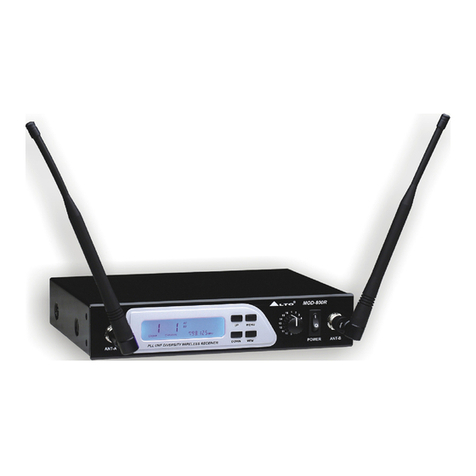
Alto
Alto MOD-800R User manual
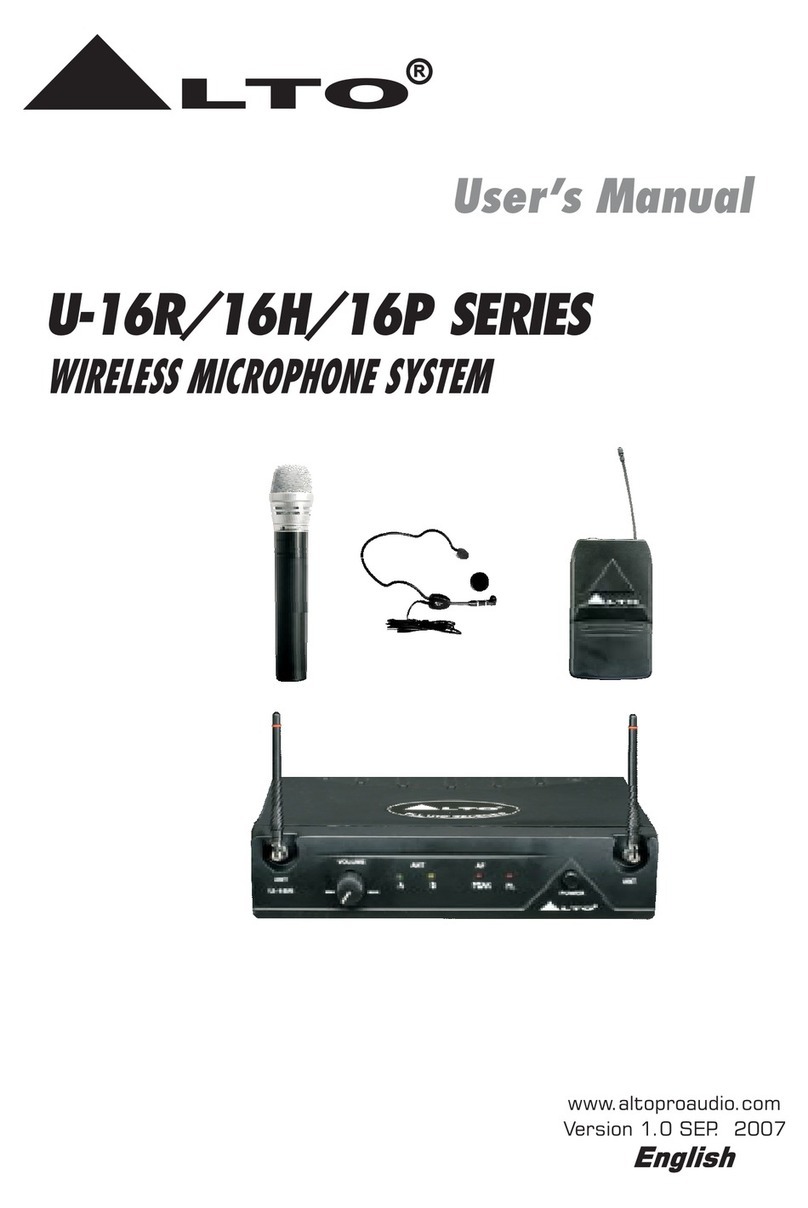
Alto
Alto U-16R SERIES User manual

Alto
Alto AU-800P Series User manual

Alto
Alto 16P SERIES User manual
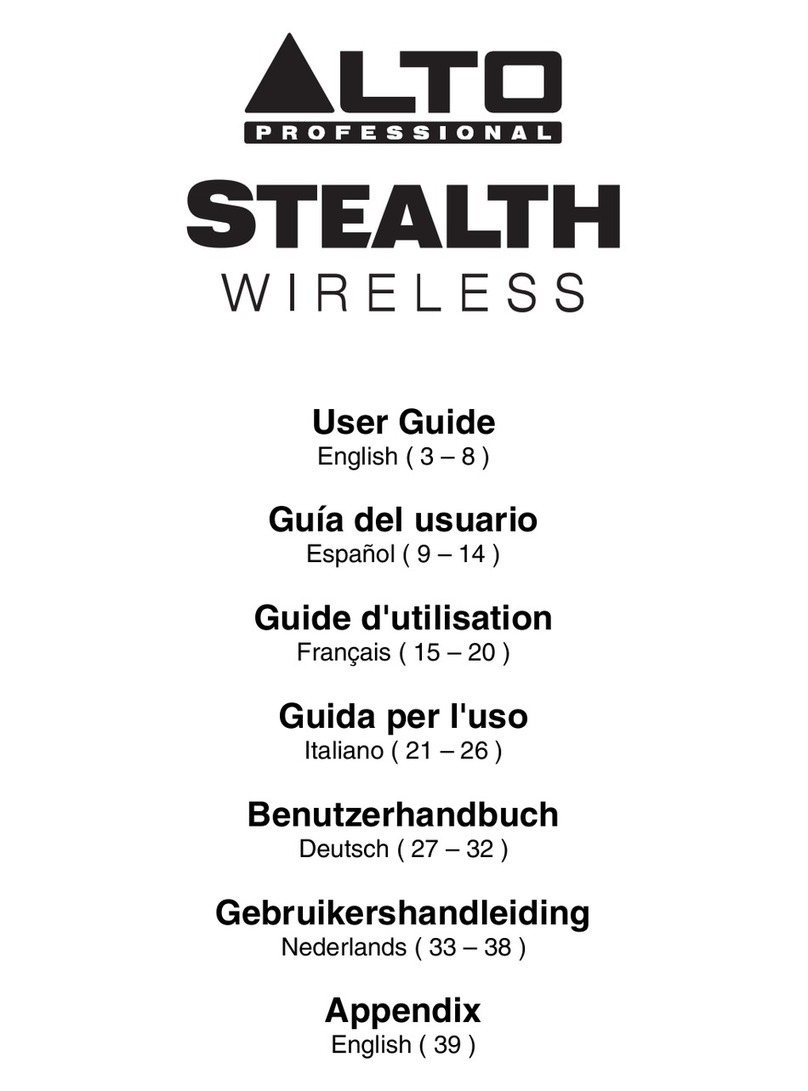
Alto
Alto Stealth Wireless User manual

Alto
Alto AU-800R Series User manual
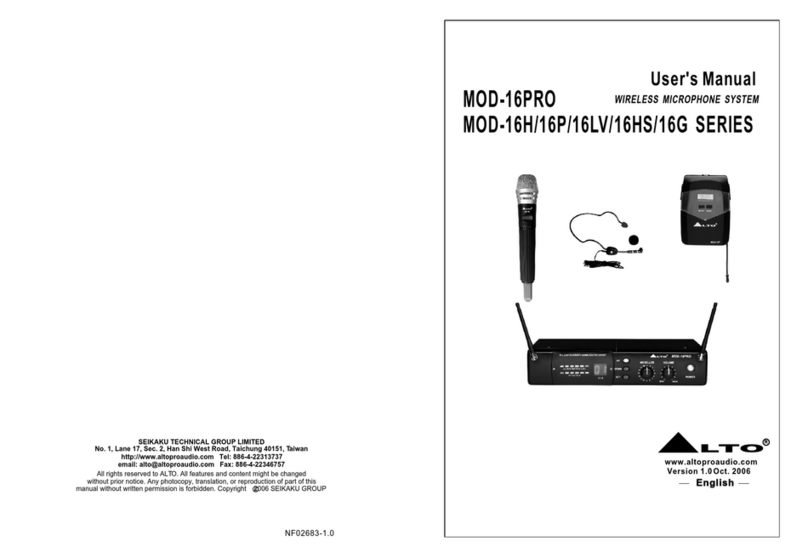
Alto
Alto MOD-16PRO Series User manual
Popular Microphone System manuals by other brands
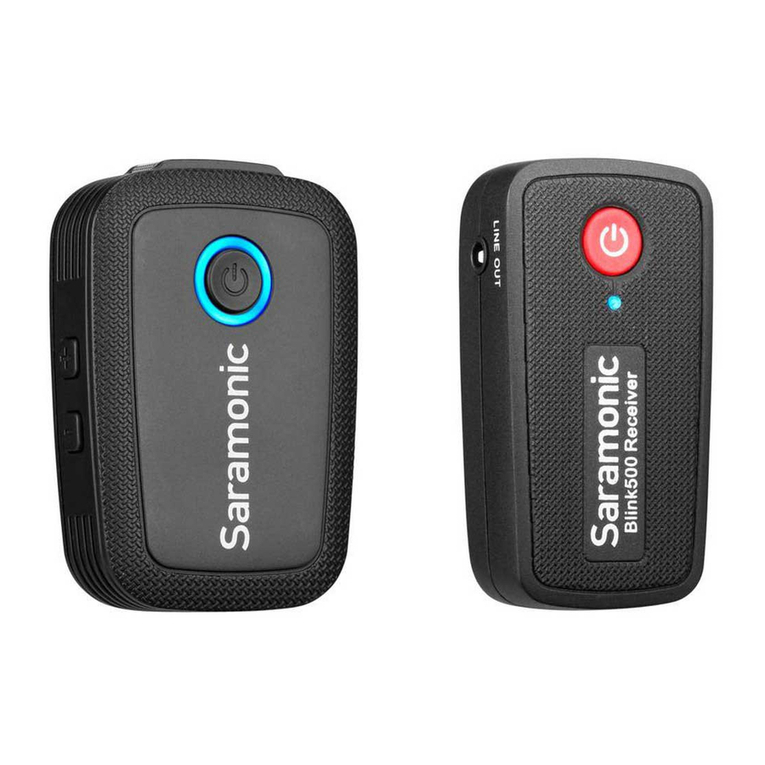
Saramonic
Saramonic Blink 500 user manual
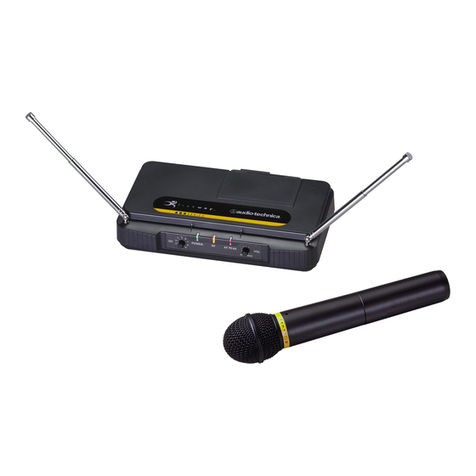
Audio Technica
Audio Technica ATW-601 Installation and operation
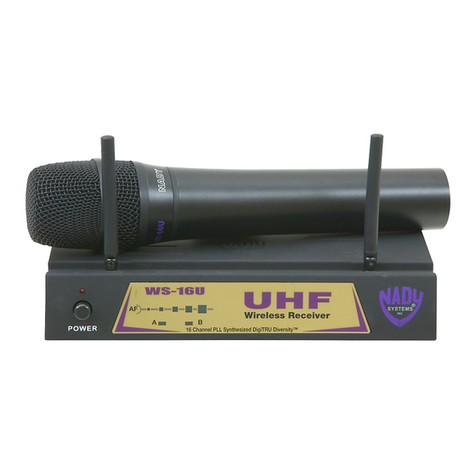
Nady Systems
Nady Systems WS-16U owner's manual

Videomitter
Videomitter MIT500 instruction manual

Extron electronics
Extron electronics VoiceLift VLP 202 Setup guide
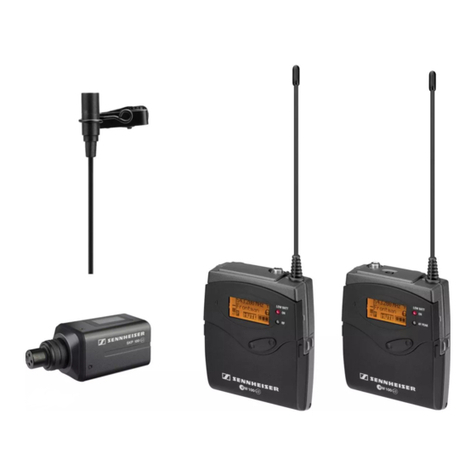
Sennheiser
Sennheiser EW 100 G3 Product sheet

